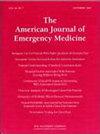扩大急症治疗和处置选择:创建急症后快速临床随访计划
IF 2.7
3区 医学
Q1 EMERGENCY MEDICINE
引用次数: 0
摘要
急诊科(ED)的到来在美国各地的医院激增,许多系统面临着巨大的能力挑战。为患者确定有效和安全的替代处置方式是解决能力和登机危机的一种方法。方法通过企业范围内多个服务线的协作,建立快速的ed后评价随访流程。该系统允许实时付款人不可知调度快速亚专科和初级保健门诊随访预约急诊科患者作为一个安全的替代住院。结果:在项目实施的前12个月,急诊科医生安排了735例转诊,其中551例(75%)的预约在医生监督领导的回顾性审查中被确定为安全避免了住院。通过预约完成情况和1周内的急诊回访来衡量项目安全性。超过80%的患者按时赴约,74名患者在7天内多次到急诊科就诊,26名患者(3.5%)在随后的就诊中入院。没有患者需要将住院治疗升级到重症监护室或中级监护室。急诊后快速临床随访项目取得了成功,为数百名患者提供了一个安全的替代方案,否则这些患者可能会在我们的急诊科住院数小时至数天。应对能力挑战的卫生系统可以考虑实施该计划的个性化版本。本文章由计算机程序翻译,如有差异,请以英文原文为准。
Expanding acute care treatment and disposition options: Creating a post-ED rapid clinic follow-up program
Background
Emergency department (ED) arrivals are surging in hospitals across the United States, with many systems facing significant capacity challenges. Identifying effective and safe alternative dispositions for patients is one solution to the capacity and boarding crises.
Methods
Our health system created a rapid post-ED evaluation follow-up process through enterprise-wide collaboration among multiple service lines. This system allowed for real-time payer agnostic scheduling of rapid subspecialty and primary care outpatient follow-up appointments for ED patients as a safe alternative to hospital admission.
Results
During the first 12 months of the program, 735 referrals were ordered by the ED physicians with 551 (75 %) of appointments identified to have safely averted a hospital admission on retrospective review by a physician oversight leader.
Program safety was measured by appointment completion and return ED visits within 1 week. More than 80 % of patients attended their appointments, 74 patients had one or more repeat visits to the ED within seven days with 26 patients (3.5 %) admitted on the subsequent visit. No patients required an escalation of inpatient care to an intensive care or intermediate care unit.
Conclusions
The post-ED rapid clinic follow-up program has been successful and provided a safe alternative to hundreds of patients who would otherwise have been admitted and often boarding in our ED for hours to days. Health systems dealing with capacity challenges may consider implementing an individualized version of this program.
求助全文
通过发布文献求助,成功后即可免费获取论文全文。
去求助
来源期刊
CiteScore
6.00
自引率
5.60%
发文量
730
审稿时长
42 days
期刊介绍:
A distinctive blend of practicality and scholarliness makes the American Journal of Emergency Medicine a key source for information on emergency medical care. Covering all activities concerned with emergency medicine, it is the journal to turn to for information to help increase the ability to understand, recognize and treat emergency conditions. Issues contain clinical articles, case reports, review articles, editorials, international notes, book reviews and more.

 求助内容:
求助内容: 应助结果提醒方式:
应助结果提醒方式:


